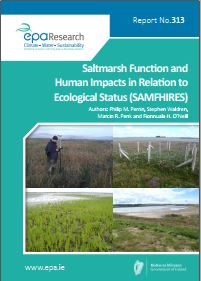Authors: Philip M. Perrin, Stephen Waldren, Marcin R. Penk and Fionnuala H. O’Neill
Summary: Coastal saltmarshes provide a range of important ecosystem services but face increasing challenges because of human activities. Ecological assessments of saltmarshes are required to inform reporting in compliance with the European Union (EU) Habitats Directive (HD) (92/43/EEC) and Water Framework Directive (WFD) (2000/60/EC).

Saltmarshes are intertidal habitats that provide a broad range of high-value ecosystem services, such as carbon storage, dissipation of wave energy and nutrient cycling, and are also recognised as important for biodiversity. However, Irish saltmarshes are subject to a number of pressures that need to be addressed if these habitats and their services are to be maintained or improved. The SAMFHIRES project (1) investigated the effects of nutrient enrichment on saltmarsh soils, plant communities and plant biomass allocation; (2) studied the effects of livestock grazing on the structure, diversity and composition of saltmarsh plant communities; (3) modelled the impacts of different sea level rise scenarios on saltmarsh extent, zonation and functions; and (4) reviewed how the effects of sea level rise could be mitigated through the managed realignment of coastal defences. In the face of these pressures, regular and informative monitoring and assessments of saltmarshes are required. This project sought to assist these processes by reviewing and amending field survey protocols, developing and applying species rarity indices, and examining the classification of less common saltmarsh communities.
Weak relationships were found between nutrient conditions within saltmarsh soils and those within associated water bodies, indicating that saltmarsh soils may be poor sentinels of eutrophication in those systems. This has repercussions for assessment procedures under the Water Framework Directive and the integrated management of these coastal and transitional water bodies. Changes in above- and below-ground biomass allocation and the abundance of key saltmarsh species with increasing nutrient enrichment are likely to have implications for ecosystem services. Overall, heavy grazing on saltmarshes results in retrogressive succession. Tall, dense vegetation resulting from a lack of livestock grazing benefits some taxa but has negative effects on others; therefore, a policy to provide a range of grazing intensities on larger sites is recommended. Losses of saltmarsh habitat and consequently some functions that provide ecosystem services occurred under a majority of plausible sea level rise simulations that did not incorporate some measure of managed realignment. However, Ireland, which lacks a national coastal defence strategy, is lagging far behind many other countries in Europe in the adoption of managed realignment as a coastal management tool.
Developed by this project, MARGOT (Marshes Governed by Tides) is a reduced-complexity, spatially explicit model in R that forecasts the impacts of different sea level rise scenarios, accretion rates and managed realignment strategies on saltmarsh habitats. Based on national plant distribution data, a “Rarity Co-efficient” and related indices were developed to incorporate taxonomic rarity into conservation evaluations that are often based solely on species richness. Community zonation is a key characteristic of Irish saltmarshes but has not been accurately mapped by past surveys because of the coarseness of the available classification systems. The mapping procedures used by field surveys that inform the European Union Habitats Directive Article 17 reporting on Annex I saltmarsh habitats have therefore been amended to incorporate more detailed categories from the Irish Vegetation Classification (IVC). Recommendations have also been made on how to incorporate less common saltmarsh communities into the IVC. Assessment criteria for Annex I habitats and metrics for assessing saltmarshes for the purposes of the Water Framework Directive have both been updated to reflect our improved understanding of saltmarsh ecology
https://www.epa.ie/media/archive/research/research-thumbnails/Thumbnail-313.jpg